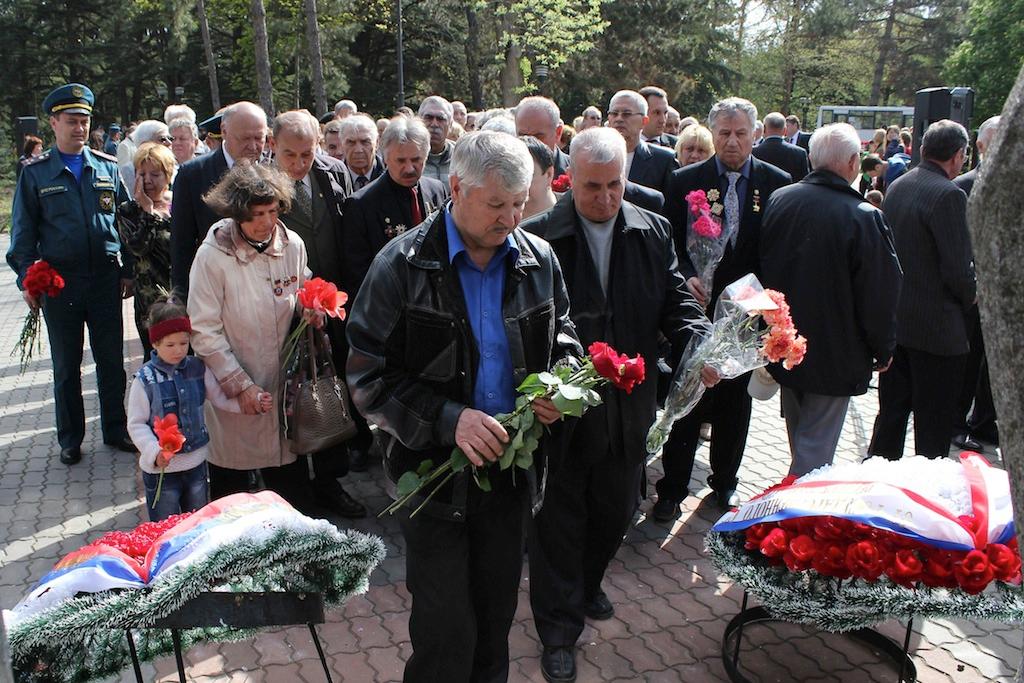In westernmost Russia, a tactical nuclear base emerges as a threat to NATO countries
People lay flowers at the Chernobyl victims’ memorial in the Crimean capital Simferopol, on April 25, 2014. The world marks tomorrow the 28th anniversary of the world’s worst nuclear disaster at Chernobyl nuclear pant in Ukraine.
NEW DELHI — In response to the US missile defense system in Poland, Russia is reported to be planning to field a tactical nuclear weapon, called the Iskander, in the region of Kalingrad, in westernmost Russia.
Many view Iskander missiles, with a range of 400 km, as a weapon that could have military and political influence.
Historically, Kalingrad was German territory until World War II and was known as Konigsberg. Germany lost the territory to the Soviet Union in 1945; at the Potsdam Conference, it became a part of the Soviet Union.
During the Cold War, Kalingrad was heavily militarized, forming a “strategic outpost” designed to avert attack from West, check on the Baltic States and exert influence over the Baltic Sea.
This is not the first time reports suggested Russia is planning to place tactical nuclear missiles in Kalingrad. In 2001, Russia fielded SS-23s and, later, the Tochkas.
The region borders Poland, a former Soviet satellite state, and Latvia, Lithuania and Estonia countries that came under authority the Soviet Union during the Cold War.
After the Crimean crisis, the idea of placing Iskander missiles in Kalingrad has made these states wary of Moscow’s intentions. Ever since Poland and the Baltic states became NATO members, Russia’s security concerns have grown.
Tactical nuclear weapons could be Russia’s message to NATO and the United States to not interfere with its expansionist strategies. Poland and Lithuania, both of which border Kalingrad, have raised concerns over the missiles. Moscow justifies it stance on its “right” to station missiles in the region as a “logical response” to the US missile defense threat.
In 2012, Lithuanian Minister of National Defense, Rasa Juknevičienė, said the test launch of the Tochka missile in the Kalingrad region confirmed Russia’s desire to “demonstrate its military power in the Baltic region.” That process continues. According to a Russian political scientist, Vladimir Abramov, Kalingrad is being viewed by the West as a “nuclear pistol.”
It would be difficult for the Baltic States and Poland to keep pace with Russia’s modernization of offensive forces. President George W. Bush’s decision to place missile defense systems in Poland and other parts of Eastern Europe, including the Czech Republic, insured that the Kalingrad region was bound to become a flash point for future nuclear conflicts.
As a party to the INF Treaty, Russia is forbidden from developing ground-launched nuclear capable ballistic and cruise missiles within a range of 500 km to 5500 km. It can only deploy nuclear weapons with a range lesser than 500 km; these weapons have to be deployed close to the borders of the territory to be threatened.
Though the United States has clarified that the missile defense system in Europe is to counter threats from rogue states like Iran, Russia does not buy it. In fact, Russia calls the Iranian missile threat portrayed by the United States as a “fairy tale.”
Moscow believes the missile defense system in Europe is designed to negate its nuclear deterrent capability. Even though the United States has cancelled the fourth phase of the missile defense system to avoid angering Russia, Moscow continues to militarize Kalingrad.
In 2008, when Poland agreed to field the Bush missile defense system, Moscow threatened Poland with nuclear attack.
As Russia continues to move its missiles closer to Kalingrad, the question that arises is will Moscow be able to launch a nuclear attack on Poland, Romania, Turkey and Spain, NATO states where US defense missiles are in place? Article 5 of the NATO Treaty obligates members, including the United States, to come to the aid of these states.
In 1991, Russia had pledged to keep the Baltic region free of nuclear weapons. However, if Russia starts to deploy its nuclear weapons in Kalingrad region, it could violate that pledge.
Russia also expresses concern over the US B-61 tactical nuclear weapons stationed in Italy, Germany and Turkey. With this concern in mind, Russia has also fielded the S-400 anti-missile systems in Kalingrad that could intercept incoming missiles. Hence, the arms build-up in Kalingrad includes both offensive and defensive weapons.
Although many analysts have suggested denuclearization of the region, such a step has never been officially taken by Moscow. If the United States is to move ahead with its own missile defense program in Europe, it must include Moscow in that program too.
Otherwise, there could be severe instability and Europe could become the next nuclear flashpoint.
Debalina Ghoshal is an associate fellow at the Centre for Air Power Studies in New Delhi.
The story you just read is accessible and free to all because thousands of listeners and readers contribute to our nonprofit newsroom. We go deep to bring you the human-centered international reporting that you know you can trust. To do this work and to do it well, we rely on the support of our listeners. If you appreciated our coverage this year, if there was a story that made you pause or a song that moved you, would you consider making a gift to sustain our work through 2024 and beyond?
